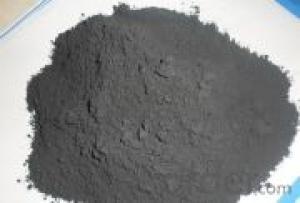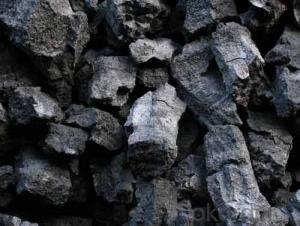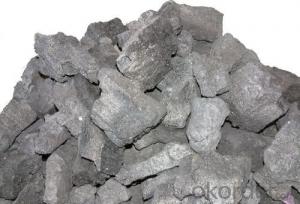COKE BREEZE OF 0 to 5mm
- Loading Port:
- Tianjin
- Payment Terms:
- TT OR LC
- Min Order Qty:
- 1000 m.t.
- Supply Capability:
- 1000000 m.t./month
OKorder Service Pledge
OKorder Financial Service
You Might Also Like
1. Structure of Metallurgical Coke of COKE BREEZE OF 0 to 5mm Description:
Coke is usually divided into metallurgical coke according to the use (including blast furnace coke, coke and ferroalloy coke, etc.), gasification coke, calcium carbide with coke and so on.
By the coal pulverized coal pressure molding, post-processing is made by carbonization, etc formed new coke carbon called formed coke.
Coke is mainly used for blast furnace ironmaking and used for copper, lead, zinc, titanium, antimony, mercury and other non-ferrous metal smelting of blast furnace, reducing agent, compound and the function of stock column frame.
Blast furnace with Coke instead of charcoal, which laid a foundation for the large-scale of modern blast furnace, is a major milestone in the history of metallurgy.
2. Main Features of the Metallurgical Coke of COKE BREEZE OF 0 to 5mm:
• Quality assurance
• Mutual benefit
• Preferential price
• Various choice
3. Metallurgical Coke of COKE BREEZE OF 0 to 5mm Images:



4. Metallurgical Coke of COKE BREEZE OF 0 to 5mm Specification:
Guarantee | Rejection | |
Total Moisture (As received basis) | 5% max | |
Ash (dry basis) | 12.5% max | > 13.5% |
Volatile Matter (dry basis) | 1.5% max | > 1.8% |
Sulphur (dry basis) | 0.65% max | > 0.75% |
Phosphorus (dry basis) | 0.035% max | > 0.045% |
M10 | 7% max | > 9% |
M40 | 84% min | <82% |
CSR | 64% min | <62% |
CRI | 26% max | > 28% |
Size 30-90 mm | 90% min | |
+90 mm | 5% max | > 8% |
-30mm | 5% max | > 8% |
5. FAQ
How about your company?
Our company began to export coke when China cancelled 40% of coke export tariffs and quotas on January 1, 2013. We export many kinds of coke, such as CSR60 % and CSR 62% metallurgical coke (met coke), the NUT coke of 20 to 50 mm, coke breeze of 3 to 6 mm, and so on.
- Q: What is the density of coke?
- Do you want to transport by rail? Ha ha, you might as well ask the freight forwarding clerk, he / she will tell you the various models of the volume and the weight can be installed, the conversion of the density of the pile is more accurate.
- Q: What does Coke test index M25 mean?
- . Coke crushing strength refers to coke can resist foreign impact force without ability along cracks or defects at the broken, represented by the M40 value; wear strength of coke coke refers to the ability to resist external friction without surface of glass forming debris or powder, said M10. The cracking degree of coke affects the M40 value of its breaking strength, and the pore structure of coke affects the M10 value. There are many methods for determination of M40 and M10, our method using migon drum test in Germany.
- Q: What is the reasonable ratio of coal to coke
- According to the proportion of each unit type, different operation, different existing coal and different coke quality requirements are different and so on, can be said to suggest that the landlord can look at the altar of the myriads of changes, in some aspects of the coal blending, grasp some general principles, and then develop the proportion according to the actual situation.
- Q: What is the difference between coking plant and coke plant
- Production equipment and production processes are complex.Coke plant, generally only the coal into coke on it, so simple.
- Q: China's coke iron smelting began in what time?
- In the early period of the Warring States period, China has mastered the technology of decarbonization and heat treatment. The late Warring States period, but also invented a reusable "Iron Fan" (made of iron casting metal utensils of the hollow device). The Western Han Dynasty, appeared the crucible process. At the same time, the further expansion of the scale of shaft furnace. In 1975, in the vicinity of Zhengzhou guxing town discovered and unearthed Han iron smelting sites, site area of 120 thousand m2, two parallel excavated foundation of blast furnace, blast furnace volume of about 50m3
- Q: What is the use of coke
- Finally made coke, this process is called high temperature coking (high temperature carbonization). Coke obtained from high temperature coking for blast furnace smelting, casting and gasification. Coke oven gas produced in the process of coking and recovery is not only a high calorific value of fuel, but also an important industrial raw material for organic synthesis
- Q: What is the difference between coke and coking coal
- Coking coal is a kind of bituminous coal with a high degree of deterioration, and the thermal stability of the resultant colloid is good when the coke is produced separately. The block size of the coke is large, the crack is small and the strength is high
- Q: the CO reduces the iron oxide, and the part of CO burns, and the whole process will release a lot of heatCheck information, combined with the knowledge of the professional knowledge, for reference purposes only!
- Thermal strength index: CSR CRIM40 M25 is the bigger the better, the smaller the better M10CSR the bigger the better the smaller the better CRISpecific standards to see the specific requirements of steel mills
- Q: The two day of the fire is not wang you have a good way to have any good way. Such online
- Coke obtained from high temperature coking for blast furnace smelting, casting and gasification. Coke oven gas produced in the process of coking and recovery is not only a high calorific value of fuel, but also an important industrial raw material for organic synthesis.
- Q: What are the national standards for grade two coke?
- Volatile content is not greater than 1.80; crushing strength: M40:76.1 - 80, M25:88.1 - 92; wear resistance: M10: not more than 8.5;
Send your message to us
COKE BREEZE OF 0 to 5mm
- Loading Port:
- Tianjin
- Payment Terms:
- TT OR LC
- Min Order Qty:
- 1000 m.t.
- Supply Capability:
- 1000000 m.t./month
OKorder Service Pledge
OKorder Financial Service
Similar products
Hot products
Hot Searches






























